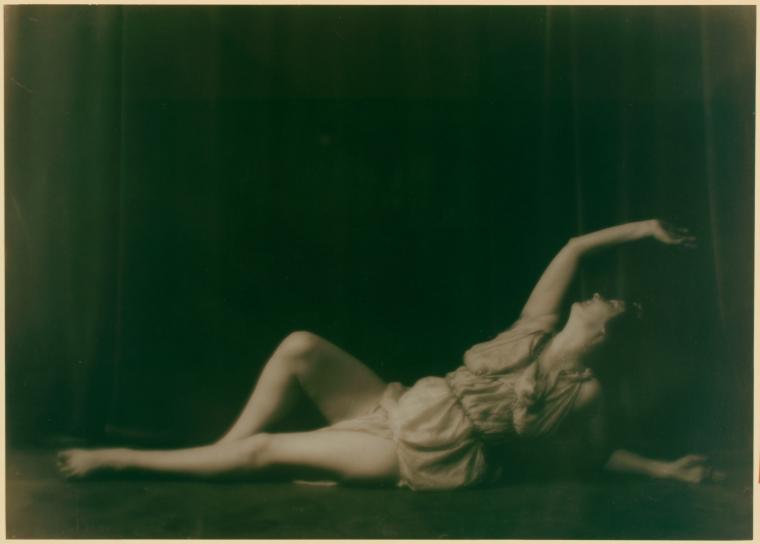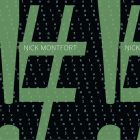Mindy Aloff’s Dance in America: A Reader’s Anthology

In I am A Lover, a quirky coffee-table book chronicling 1950’s California bohemia featuring black and white street photography juxtaposed with quotations by everyone from Al-Ma’arri to Madame de Pompadour, readers will find the following lines:
There are moments in man’s mortal years
When for an instant that which long has lain
Beyond our reach is on a sudden found
In things of smallest compass, and we hold
The unbounded shut in one small minute’s space,
And worlds within the hollow of our hand.
H.B. Carpenter’s image gestures toward a momentary transcendence, which the editors of the book, Jerry Stoll and Evan S. Connell Jr., associate with images of young children participating in the creation of art: in one, a boy sits in his father’s lap, hands ablur, drumming away. In another shot, three children concentrate upon a potter at work with the wheel.
I thought, instead, of perhaps one of the most intuitively compelling descriptions of classical ballet by one of its foremost writers, poet Edwin Denby. Of course, for spectators, nothing about dance as it unfolds in time can be held in the hand to be turned about in the light with contemplative leisure. Even Ralph Waldo Emerson remarks that the draw of the Viennese ballerina Fanny Elssler lies within the fact that she presents a form of excellence through “some occult foundations of inward harmony.” It is something that appeals to broad audiences, for “she dances for them or they dance in her not being . . . able to dance themselves. We must be expressed.” The question of who, really, is the “we” in this formulation is compelling. And how best to articulate the effects of expression through dance?
Mindy Aloff’s most recent book, Dance in America: A Reader’s Anthology, published by the Library of America, provides a variety of perspectives on these questions and more. The challenge of her project stands not only in relation to the mass of written material to potentially engage, but in how to remain in keeping with the Library’s undertaking “to celebrate the words that have shaped America” when dealing with an artform that, as George Balanchine has remarked, creates a world “where there are no names for anything.” In Dance, Aloff makes a case for a unique arrangement of texts, featuring writing about American dance spanning two centuries, with a focus on work from the twentieth. She draws upon a variety of genres, including poems, translations, transcripts of statements, letters, fiction, journal entries, as well as the expected reviews by professional dance critics.
Among the key questions Aloff poses—and offers the anthology as a collective answer to—include, “What is a ‘Library of America’ author? What does ‘America’ mean in this context?” These questions, of course, involve an evolving canon as well as gesture toward debates about access and elitism—issues particularly sensitive in American contexts—that often accompany conversations about dance. By dedicating the volume to the New York Public Library of the Performing Arts at Lincoln Center, Aloff comments upon the wider significance of such a dedication: “The Library is open to all, for free. And yet the democracy of its public access is inseparable from the uncommon ideals its materials embody. The Library offers the best to the most, and it makes everyone who uses it an elite cadet in service of civilization.” In large part, Aloff succeeds in her endeavors by providing non-specialist readers—hence the subtitle “A Reader’s Anthology”—measures of enjoyment, access, new perspectives and insight into this often inscrutable artform.
Readers looking for a chronological narrative arc will be disappointed; nor are genres directly apparent in the contents, which are arranged within a neutral alphabetical order by author name. One advantage of this organization is that non-specialist readers will find surprises as they happen to appear throughout the pages. A difficulty may be the losing of a thread, for those same reasons, of thought devoted to a certain form of dance, say, or principal dancer, or a choreographer. The variety at the heart of the work, however, provides readers with access to create, or not, a series of narratives about the uncommon ideals it presents: it is a democratic invitation in itself.
The earliest prose piece, from 1821, comes with the distinction of being the first of its kind written in English in America. Among John Durang’s breathless accounts, the most memorable moment occurs within his description of not being able to learn a certain dance he was fascinated by, the “pigeon wing,” from a traveling Frenchman. He figured it out in a dream, in which he danced the step before an admiring audience and, upon waking, “rose in the confidence of doing the step” and was thereafter not only able to perform it, but also to teach it to others. This blending of dance with the motions of the subconscious mind has considerable symbolic resonance through the work, through time and across cultures.
In addition to the entertainment and aesthetic pleasure dance provides, readers glimpse the ways in which it also is used to powerful effect in ceremonial contexts, serving purposes from healing to destruction. In an excerpt from Black Elk Speaks, the 1932 book by John G. Neihardt, Black Elk, medicine man of the Oglala Lakota Sioux, describes his Horse Dance, revealing not only the ceremonial properties of the art, but also ways in which it transcends the human. Horses, birds, plants, even thunder clouds play a role in the enactment in which the entire village takes part. In an ecstatic sequence, Black Elk describes how he sees himself mirrored in the sky among the Six Grandfathers as he is dancing in the present moment: “I looked about me and could see that what we then were doing was like a shadow cast upon the earth from yonder vision in the heavens, so bright it was and clear. I know the real was yonder and the darkened dream of it was here.” People who were suffering in the village gave offerings in exchange for the healing the ceremony provided and “began to dance for joy.”
Harlem Renaissance novelist and anthropologist Zora Neale Hurston contributes a different dimension entirely to the ceremonial facets of dance. The story “Hoodoo,” which Hurston included in her own collection of African American folktales, Mules and Men, relates the tale of Kitty Brown, “a well-known hoodoo doctor of New Orleans, and a Catholic.” Kitty is a matchmaker, but she also holds the knowledge of how to conduct a ceremonial hoodoo dance, “always a case of death-to-the-enemy that calls forth the dance.” An elaborate and physically grueling ceremony, it is rare, with very few people permitted to witness. Though this tale did not end in the death of an unfaithful lover, it did produce a resounding corrective effect.
W.H. Auden, as accomplished as a critic as he was as a poet, observes how dance, in this case ballet, inhabits “a continuous present.” While this is not necessarily transcendent in the ways ceremonial dance can be, for Auden, this eternal present bears an Edenic quality. Exempt from expressions of memory, “all real ballets take place in Eden,” he writes, “in that world of pure being without becoming and the suffering implied by becoming, a world where things, beasts, and men are equally alive, a world without history and without seriousness.” That is not to say that a ballet such as The Nutcracker is juvenile; it is only so for those “who have lost their sense of joy” and are thereby unable to take pleasure of find meaning in it.
Entries by Isadora Duncan, referred to by the editor as the Mother of Modern Dance, bring yet another perspective that places women at the center of this artform. One of the earliest photos in the anthology features a Duncan dancing with the Theater of Dionysus in the background, looking startlingly like a woman dashing to life from a scene upon an ancient Greek frieze. In “The Dance of the Future,” Duncan insists that the style of dance she envisions does not merely attempt to revive a classical style lost to antiquity, for after all, “We are not Greeks and cannot therefore dance Greek dances.” And yet she proclaims that “the dance of the future will have to become again a high religious art as it was with the Greeks. For art which is not religious is not art, is mere merchandise.” What she has in mind must be led by women: the dancer of the future “will help womankind to a new knowledge of the possible strength and beauty of their bodies and the relation of their bodies to the earth nature and to the children of the future. She will dance the body emerging again from centuries of civilized forgetfulness.” In order for this progressive vision to become possible—she proclaimed it in 1903!—Duncan recognized how important it was to found schools of dance wherever possible.
The essential role of early education in dance is important not only to nurture future luminaries, but also, on a much larger scale, to ensure that dance remains a viable form for adult audiences of the future. Balanchine shared Duncan’s recognition of the centrality of woman, for him of course in the context of ballet, as well the importance of providing opportunities for children to watch free performances—arguing before the NEA and NEH were in existence that such shows be funded both privately and with government support—performed by professional dancers. To his credit, moreover, Balanchine knew and resisted pandering depictions of women onstage that reduced them either to vampiric or languid ethereal roles. With his inimitable capacity for understatement, he remarks that on the contrary, “some very good dancers that I have seen in my life were beautifully cold, like birds with no warmth at all.” Many more pieces from the anthology are from dancers in Balanchine’s company, or from commentators who knew him and his work. These appear alongside many more by or about Martha Graham, Josephine Baker, Ginger Rogers and Fred Astaire, Alvin Ailey, and many others too numerous to discuss here.
Most of these pieces articulate certain aspects of dance across cultures that reveal its transcendent effects. Denby, however, captures the sense of timelessness that comes from an act unfolding in time in his description of a rare form of weightless leap that, for him, you sometimes witness in classical ballet. Most of the time, leaps are “a tough thrust off the ground, some travel like a cat’s, some quiver like a fish’s, some scintillate like jig steps,” but these are not what Denby has in mind. “A leap is a whole story, with a beginning, a middle, and an end,” with its highest point he calls a “a climax of repose. The dancer must not be thinking of either how she got up or how she is going to get down. She must find time just then to meditate.” It is clear that this is not about a technical display of talent for even the few who can manage it at all. Rather, it is something that offers audiences, and readers who must imagine it, spontaneous experience “as supernatural, as a strangely beneficent magic. It is an approach to those mysterious hints of gentleness that occasionally absorb the human mind.”



